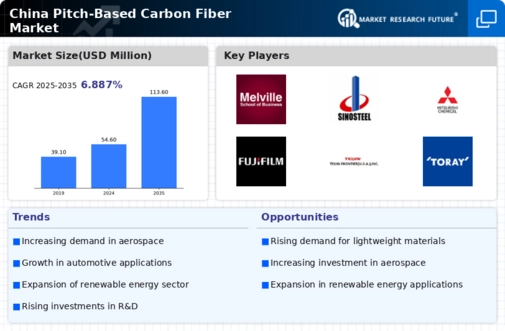The China Pitch-Based Carbon Fiber Market is characterized by its dynamic landscape with a variety of players contributing to its competitive nature. The market has been witnessing significant growth driven by the demand for high-performance materials across various sectors, including aerospace, automotive, and industrial applications. As the country continues to emphasize advancements in technology and innovation, companies are increasingly focused on enhancing their manufacturing capabilities and developing new applications for pitch-based carbon fiber. This sector shows potential for increased production capacity, collaboration among companies, and the development of strategic partnerships to gain a competitive edge in the market.
The trend towards sustainability is also prompting organizations to explore more eco-friendly production methods, thereby reshaping the competitive framework of the industry. Kwantlen Polytechnic University has established a noteworthy presence in the China Pitch-Based Carbon Fiber Market through its extensive research and development initiatives. The institution is known for its commitment to innovation in material science and manufacturing processes, making it a vital player in advancing pitch-based carbon fiber technology. By engaging in collaborations with industry partners, Kwantlen Polytechnic University successfully translates theoretical research into practical applications, thereby bolstering its influence within the market.
The university's strengths lie in its cutting-edge laboratories and expert faculty, which not only foster experimental methodologies but also cultivate a talent pool that can contribute to the sector's growth. The university's focus on nurturing partnerships with local and international firms further enhances its role as a thought leader in this competitive market. Sinosteel has emerged as a prominent entity within the China Pitch-Based Carbon Fiber Market, recognized for its comprehensive portfolio of products and services that cater to various industrial needs. The company specializes in the production of pitch-based carbon fibers, integrating advanced manufacturing techniques to ensure high-quality outputs.
With a robust market presence, Sinosteel leverages its extensive operational capabilities and strong supply chain networks to effectively meet the rising demand in China. The company's strengths include its commitment to research and development, which has led to innovative solutions tailored to specific applications in industries such as construction, automotive, and aerospace. Sinosteel has pursued several strategic mergers and acquisitions to enhance its market position, enabling it to expand operations and improve product offerings, all while maintaining a focus on sustainable practices in production to align with global industry trends.
This approach not only strengthens its competitive position but also prepares the company for future challenges and opportunities inherent to the market dynamics in China.




















